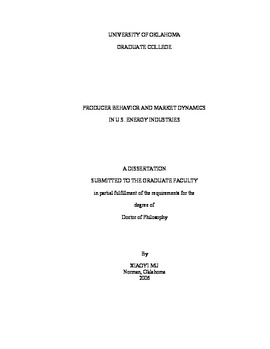| dc.contributor.advisor | Dunne, Timothy, | en_US |
| dc.contributor.author | Mu, Xiaoyi. | en_US |
| dc.date.accessioned | 2013-08-16T12:20:08Z | |
| dc.date.available | 2013-08-16T12:20:08Z | |
| dc.date.issued | 2006 | en_US |
| dc.identifier.uri | https://hdl.handle.net/11244/1039 | |
| dc.description.abstract | The third essay, "Measuring Unilateral Market Power: An Application to the Texas Deregulated Electricity Market" analyzes the unilateral market power in the balancing electricity market in Texas. This essay follows the recent work of Wolak (2003) and develops measures of market power for the two largest firms based on the inverse of the ex post residual demand elasticities. The results indicate that the firm with the largest stake in the balancing market has consistently higher market power than the other firm even though both firms are about equally sized in terms of installed capacity. Further, most price spikes during the sample period are associated with at least one firm's exceptionally high market power. Finally, the lack of bids from smaller suppliers appears to contribute to the largest firms' market power and may exacerbate price spikes. | en_US |
| dc.description.abstract | The second essay, "Weather, Storage, and Natural Gas Price Dynamics: Fundamentals and Volatility" examines how weather shocks impact asset return volatility in the U.S natural gas futures market. The results show that weather shocks have a significant impact on both the conditional mean and the conditional volatility of natural gas returns. The inclusion of the weather shock and inventory surprise variables in the variance equation reduces volatility persistence by approximately forty percent. Consistent with the literature, the volatility is considerably higher on Monday and the day when the natural gas storage report is released. Finally, this essay also provides support for the "Samuelson effect" in the natural gas market that the volatility of commodity futures declines with the contract horizon. | en_US |
| dc.description.abstract | This dissertation studies producer behavior and market dynamics in three important industries in the energy sector. The first essay, "Investment under Uncertainty: An Analysis of Capacity Adjustment in the Petroleum Refining Industry" investigates the effect of uncertainty on the investment decisions of petroleum refineries in the US. Uncertainty measures are constructed from commodity futures markets which capture the forward-looking nature of investment. Rather than relying on accounting information, data on actual capacity changes is used to measure investment episodes. Capacity changes in US refineries occur infrequently and a small number of investment spikes account for a large fraction of the change in industry capacity. This essay finds that an increase in uncertainty measures decreases the probability a refinery adjusts its capacity. The results are robust to various investment thresholds and uncertainty measures used in the analysis. Our findings lend support to theories emphasizing the role of irreversibility in investment decisions. | en_US |
| dc.format.extent | x, 106 leaves : | en_US |
| dc.subject | Petroleum industry and trade United States Capital investments. | en_US |
| dc.subject | Weather Economic aspects United States. | en_US |
| dc.subject | Electric utilities Rates Texas. | en_US |
| dc.subject | Electric utilities Deregulation Texas. | en_US |
| dc.subject | Natural gas United States Prices. | en_US |
| dc.subject | Economics, General. | en_US |
| dc.title | Producer behavior and market dynamics in United States energy industries. | en_US |
| dc.type | Thesis | en_US |
| dc.thesis.degree | Ph.D. | en_US |
| dc.thesis.degreeDiscipline | Department of Economics | en_US |
| dc.note | Source: Dissertation Abstracts International, Volume: 67-03, Section: A, page: 1027. | en_US |
| dc.note | Adviser: Timothy Dunne. | en_US |
| ou.identifier | (UMI)AAI3212016 | en_US |
| ou.group | College of Arts and Sciences::Department of Economics | |
